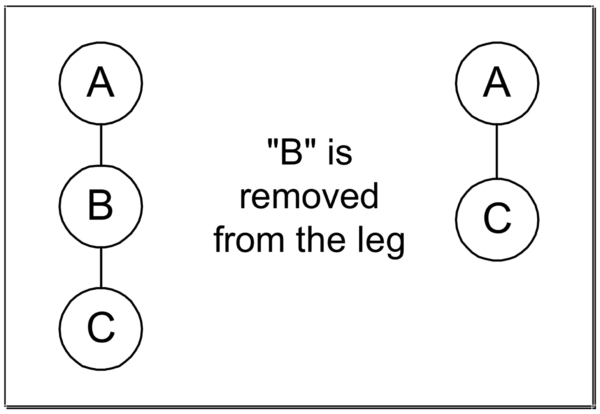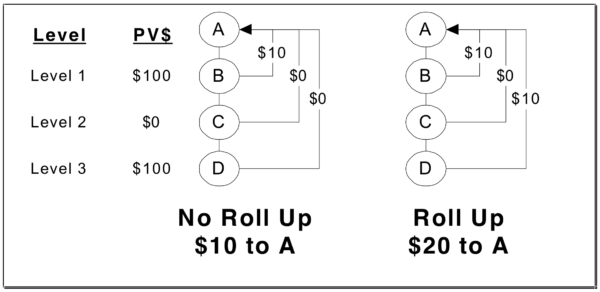Compression. Of all the techniques used to fine tune a MLM compensation plan, compression is one which is most often used, but seldom understood. For many MLM and Direct Sales companies, compression is a source of massive waste in their compensation plan – dollars being spent with little return. For others, it is a source of focused and well planned incentives on distributor performance which is otherwise difficult to obtain.
Roll Up and Compression – what are they really?
Compression and Roll Up are terms often used interchangeably in network marketing. Compression can be defined as:
The impact on a genealogy when a distributor is terminated. The downline of the terminated distributor is linked to the sponsor of the terminated distributor causing a “compression” effect on the downline.
Compression, therefore, relates to the effect of removing a distributor from a genealogy leg as in the following example:
 In this example, distributor B is removed from the genealogyresulting in distributor “C” being relinked to “A”. When “B” is removed, his entire first level is linked to their new sponsor, “A”, and all other downline distributors move up one level closer to “A”, compressing the downline by the one level vacated by “B”. This is called compression.
In this example, distributor B is removed from the genealogyresulting in distributor “C” being relinked to “A”. When “B” is removed, his entire first level is linked to their new sponsor, “A”, and all other downline distributors move up one level closer to “A”, compressing the downline by the one level vacated by “B”. This is called compression.
Roll Up Defined
If a commission payment cannot be paid to a distributor due to that distributor’s being inactive, unqualified or not eligible, the payment will “roll up” to the next qualified, active and eligible distributor upline. For example, a simple uni-level plan pays 10% to level 1 and 10% to level 2, but only if the distributor purchases $100 in the month.
The next example shows the effect Roll Up has on the commission of “A”.
Without roll up, A receives a level 1 commission from B’s $100 purchase, no level 2 commission from “C” because C purchased nothing, and no commission from D because D is at level 3, beyond the reach of A (the plan only pays 2 levels).
With Roll Up, A receives $10 from B, nothing from C (no purchase volume), and for this month only (next month C may be active, again), D is counted as 2nd level to A and A receives 10% on D’s $100 purchase. Conceptually, A receives commissions on two active levels with roll up and, therefore, reaches deeper, ignoring inactives, when counting levels.
If “C” had purchased some product, but not enough to be active, then “C” would also be counted as 2ndlevel to “A”. In this case, both C and D would be counted as 2nd level to A, but only for the current month. Confused? Who said network marketing was simple?
Why offer Roll Up?
A golden rule of compensation plan design is to apply the incentive dollars toward the behavior that is desired (see “Are You Wasting Your Hard-Earned Commission Dollars?” Jenkon Newsletter). What behavior can roll up buy?
To help sales leaders work deeply in their downline
Sales leaders often find a one or more distributors many levels below them who need their help and attention because they cannot get it from their immediate upline. The sales leader is forced to work around the inactive or uncooperative manager(s) directly with the needful distributors. Would a sales leader spend their valuable time with these needful distributors, however, if he or she felt there was little potential reward? The deeper a group is, the less the potential reward for the upline sales leader because when the group catches fire, they will build below themselves even deeper and eventually out of reach of the salesleader’s commission check. Hence, sales leaders soon learn that without roll up, they need to ignore the deep distributors needing help and focus on the closer ones. With roll up, however, the inactive sponsors in between are ignored, so the sales leader can expect to reap the benefits of their efforts on a long term basis – depth is determined only by those who are active. Roll up, therefore, entices sales leaders to work deep because it offers them a return on their time.
To entice sales leaders to move up the ranks by reaching deeper
The deeper a person can reach for commissions, the larger their check will be (assuming they have a large downline). Sales leaders know that the largest earnings come from the volume at their deepest reach because there are more producers there – the deeper you go, the more people in the downline, level by level. Roll up can be used as a significant enticement for ambitious sales leaders who want to earn from yet deeper ranks of distributors in their organizations. For example, if a plan provides roll up to only the top three ranks of sales leaders, then lesser sales leaders will be striving aggressively to reach those top three positions because their commission checks will be substantially larger from the existing volume being generated. It would be like getting a huge raise!
Mistakes to avoid
Mistake #1: Offering roll up to most distributors
Many plans I have seen offer roll up to most distributors as if it would turn on a huge amount of additional performance across the board. This is not so. Roll up works most effectively with sales leaders who have large organizations. It offers little incentive for distributors with shallow organizations because they already earn commissions from them.
Mistake #2: My competitors do it, so I should, too
Don’t fall into the trap of doing it just because others do it. Do it because it’s right for you. Roll Up costs your competitors a lot of money which you, instead, could put into other parts of your plan and get higher returns (desirable distributor behavior).
Mistake #3: Giving roll up to non producers
Understanding what behavior is bought with roll up, it becomes apparent that it should focus on active, qualified, performing sales leaders. Giving roll up to less performing distributors should be considered a waste of precious incentive dollars.
Mistake #4: Not budgeting for roll up
Roll up is expensive because it almost always pays out to the maximum limit of the plan. Without roll up, the company retains breakage to a much larger degree. Plans with roll up should expect to pay out close to their theoretical maximum.
Conclusion
Roll up can be a tremendous incentive for your active sales leaders who have large downlines. If you are giving away roll up commissions to nonproducers, to the less active, or to those with shallow downlines, consider making some changes in your plan in the future.







